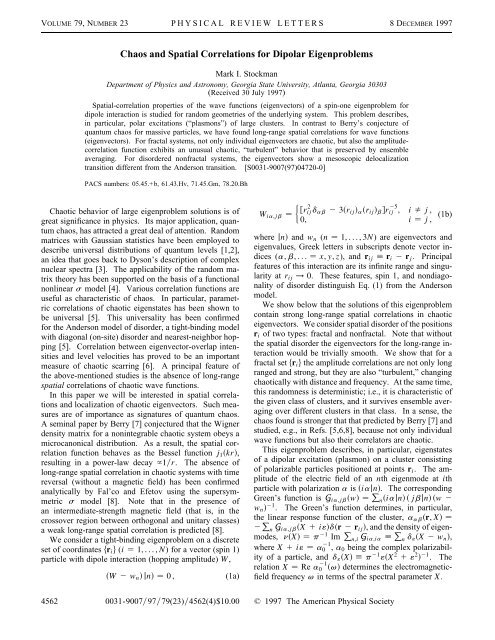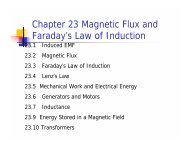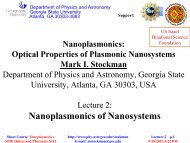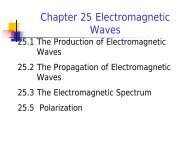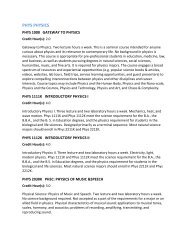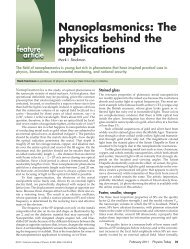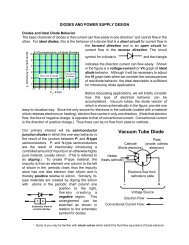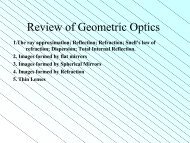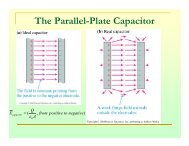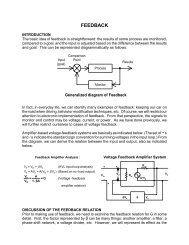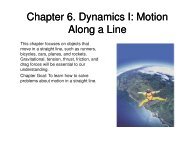PDF file - Physics & Astronomy - Georgia State University
PDF file - Physics & Astronomy - Georgia State University
PDF file - Physics & Astronomy - Georgia State University
- No tags were found...
Create successful ePaper yourself
Turn your PDF publications into a flip-book with our unique Google optimized e-Paper software.
VOLUME 79, NUMBER 23 PHYSICAL REVIEW LETTERS 8DECEMBER 1997<br />
Chaos and Spatial Correlations for Dipolar Eigenproblems<br />
Mark I. Stockman<br />
Department of <strong>Physics</strong> and <strong>Astronomy</strong>, <strong>Georgia</strong> <strong>State</strong> <strong>University</strong>, Atlanta, <strong>Georgia</strong> 30303<br />
(Received 30 July 1997)<br />
Spatial-correlation properties of the wave functions (eigenvectors) of a spin-one eigenproblem for<br />
dipole interaction is studied for random geometries of the underlying system. This problem describes,<br />
in particular, polar excitations (“plasmons”) of large clusters. In contrast to Berry’s conjecture of<br />
quantum chaos for massive particles, we have found long-range spatial correlations for wave functions<br />
(eigenvectors). For fractal systems, not only individual eigenvectors are chaotic, but also the amplitudecorrelation<br />
function exhibits an unusual chaotic, “turbulent” behavior that is preserved by ensemble<br />
averaging. For disordered nonfractal systems, the eigenvectors show a mesoscopic delocalization<br />
transition different from the Anderson transition. [S0031-9007(97)04720-0]<br />
PACS numbers: 05.45.+b, 61.43.Hv, 71.45.Gm, 78.20.Bh<br />
Chaotic behavior of large eigenproblem solutions is of<br />
great significance in physics. Its major application, quantum<br />
chaos, has attracted a great deal of attention. Random<br />
matrices with Gaussian statistics have been employed to<br />
describe universal distributions of quantum levels [1,2],<br />
an idea that goes back to Dyson’s description of complex<br />
nuclear spectra [3]. The applicability of the random matrix<br />
theory has been supported on the basis of a functional<br />
nonlinear s model [4]. Various correlation functions are<br />
useful as characteristic of chaos. In particular, parametric<br />
correlations of chaotic eigenstates has been shown to<br />
be universal [5]. This universality has been confirmed<br />
for the Anderson model of disorder, a tight-binding model<br />
with diagonal (on-site) disorder and nearest-neighbor hopping<br />
[5]. Correlation between eigenvector-overlap intensities<br />
and level velocities has proved to be an important<br />
measure of chaotic scarring [6]. A principal feature of<br />
the above-mentioned studies is the absence of long-range<br />
spatial correlations of chaotic wave functions.<br />
In this paper we will be interested in spatial correlations<br />
and localization of chaotic eigenvectors. Such measures<br />
are of importance as signatures of quantum chaos.<br />
A seminal paper by Berry [7] conjectured that the Wigner<br />
density matrix for a nonintegrable chaotic system obeys a<br />
microcanonical distribution. As a result, the spatial correlation<br />
function behaves as the Bessel function j 1 kr,<br />
resulting in a power-law decay ~1r. The absence of<br />
long-range spatial correlation in chaotic systems with time<br />
reversal (without a magnetic field) has been confirmed<br />
analytically by Fal’co and Efetov using the supersymmetric<br />
s model [8]. Note that in the presence of<br />
an intermediate-strength magnetic field (that is, in the<br />
crossover region between orthogonal and unitary classes)<br />
a weak long-range spatial correlation is predicted [8].<br />
We consider a tight-binding eigenproblem on a discrete<br />
set of coordinates r i (i 1,...,N) for a vector (spin 1)<br />
particle with dipole interaction (hopping amplitude) W,<br />
W 2 w n jn 0,<br />
(1a)<br />
W ia,jb <br />
Ω<br />
r<br />
2<br />
ij d ab 2 3r ij a r ij b r 25<br />
ij , i fi j ,<br />
0, i j ,<br />
(1b)<br />
where jn and w n (n 1, . . . , 3N) are eigenvectors and<br />
eigenvalues, Greek letters in subscripts denote vector indices<br />
(a, b,... x,y,z), and r ij r i 2 r j . Principal<br />
features of this interaction are its infinite range and singularity<br />
at r ij ! 0. These features, spin 1, and nondiagonality<br />
of disorder distinguish Eq. (1) from the Anderson<br />
model.<br />
We show below that the solutions of this eigenproblem<br />
contain strong long-range spatial correlations in chaotic<br />
eigenvectors. We consider spatial disorder of the positions<br />
r i of two types: fractal and nonfractal. Note that without<br />
the spatial disorder the eigenvectors for the long-range interaction<br />
would be trivially smooth. We show that for a<br />
fractal set r i the amplitude correlations are not only long<br />
ranged and strong, but they are also “turbulent,” changing<br />
chaotically with distance and frequency. At the same time,<br />
this randomness is deterministic; i.e., it is characteristic of<br />
the given class of clusters, and it survives ensemble averaging<br />
over different clusters in that class. In a sense, the<br />
chaos found is stronger that that predicted by Berry [7] and<br />
studied, e.g., in Refs. [5,6,8], because not only individual<br />
wave functions but also their correlators are chaotic.<br />
This eigenproblem describes, in particular, eigenstates<br />
of a dipolar excitation (plasmon) on a cluster consisting<br />
of polarizable particles positioned at points r i . The amplitude<br />
of the electric field of an nth eigenmode at ith<br />
particle with polarization a is iajn. The corresponding<br />
Green’s function is G ia,jb w P niajnjbjnw 2<br />
w n 21 . The Green’s function determines, in particular,<br />
the linear response function of the cluster, a ab r, X <br />
2 P n G ia,jb X 1 i´dr 2 r ij , and the density of eigenmodes,<br />
nX p 21 Im P n,i G ia,ia P n d´X 2 w n ,<br />
where X 1 i´ a0 21 , a 0 being the complex polarizability<br />
of a particle, and d´X p 21´X2 1´2 21 . The<br />
relation X Re a0 21 v determines the electromagneticfield<br />
frequency v in terms of the spectral parameter X.<br />
4562 0031-90079779(23)4562(4)$10.00 © 1997 The American Physical Society
VOLUME 79, NUMBER 23 PHYSICAL REVIEW LETTERS 8DECEMBER 1997<br />
The imaginary part of the polarizability determines the<br />
dynamic form factor S ab r,X, i.e., the correlation function<br />
of amplitudes at two points separated by a distance r<br />
for eigenvalues w n in the vicinity of X. Namely,<br />
S ab r, X 1 p Im a abX,r<br />
* X<br />
iajnjbjnd´X 2 w n <br />
n,i,j +<br />
3dr2r ij , (2)<br />
where ··· denotes the ensemble average over different<br />
random realizations of the system. The same function<br />
also defines the correlation of the equilibrium fluctuations<br />
of the polarization according to the fluctuation-dissipation<br />
theorem [9]. S ab r,X is the vector counterpart of the<br />
correlation function studied in Ref. [7].<br />
Another useful measure is the second-order pair correlation<br />
function C, i.e., the correlator of probabilities (or<br />
field intensities * for the corresponding classical problem), +<br />
X<br />
Cr, X iajn 2 jbjn 2 d´X 2 w n dr 2 r ij .<br />
n,i,j<br />
(3)<br />
The irreducible second-order correlation function is defined<br />
as<br />
* +<br />
Cr, X X<br />
˜Cr, X 2 I i X I j X dr 2 r ij , (4)<br />
nX<br />
i,j<br />
where the probability (intensity) at a given site i for eigenvalues<br />
w n X is introduced as I i X P niajn 2 3<br />
d´X 2 w n nX. Different from Eq. (3), the correlation<br />
function (4) separates correlation of random fluctuations<br />
from variations of expectation values.<br />
The integral irreducible correlation factor of the quantum<br />
probabilities (or classical intensities) is<br />
K p,q X P p P q X P p X P q X 2 1, (5)<br />
where the moments of probability are defined as<br />
P p P iiajn 2p , and as above, ··· X P n··· 3<br />
d´X 2 w n nX, an average over a narrow spectral<br />
interval of w n X for a given realization of the system.<br />
Note that useful information is obtained only for p, q $ 2<br />
due to normalization. The correlation factor (5) is similar<br />
to the factor studied in Ref. [8]. Asymptotically for large<br />
systems (N ! `), it characterizes long-range spatial<br />
correlations in the eigenvectors.<br />
We have performed numerical computations using two<br />
types of random sets r i of size N 1500: random<br />
lattice gas (RLG) and cluster-cluster aggregates (CCA).<br />
Fractal CCA sets (Hausdorff dimensionality D 1.75)<br />
have been generated on a cubic 3D lattice with unit<br />
period according to Refs. [10,11]. The RLG sets have<br />
been obtained by randomly positioning N points within<br />
a sphere. The density of RLG sets was adjusted to yield<br />
their gyration radius equal to that of the CCA sets. Typically,<br />
the ensemble averaging has been carried out over<br />
300 independent realizations of each type of the sets r i .<br />
The results for the dynamic form factor Sr, X <br />
1<br />
3 S bbr, X [Eq. (2)] for RLG sets and X , 0 are presented<br />
in Fig. 1 (a similar picture is obtained for X . 0).<br />
We see that for extremely large eigenvalues (jXj * 1), the<br />
form factor Sr, X has a quasirandom structure that is reproducible<br />
under the ensemble averaging. In the middle of<br />
the spectral region (0.003 & jXj & 1), the form factor is<br />
dominated by a few branches of excitation. The strongest<br />
one is marked on the lower panel by a solid white line<br />
X 22r 23 , which is the corresponding branch of binary<br />
approximation [12] (where eigenmodes consist of two “hot<br />
spots”) for X , 0, given by<br />
Sr, X drnX 1 fr<br />
3 dX 1 2r 23 2dX22r 23 <br />
12dX2r 23 22dX1r 23 , (6)<br />
where fr is a smooth distribution function of the<br />
distance r ij , fr Ndr 2 r ij . The weaker feature,<br />
marked by the dotted line X 21 1 p 57 r 23 , is due<br />
FIG. 1. Dynamic form factor Sr, X for RLG (N 1500),<br />
obtained by averaging over an ensemble of 300 individual sets.<br />
A pro<strong>file</strong> on double-logarithmic scale in r and X is shown<br />
in the upper panel and the corresponding contour map in<br />
the lower panel. The vertical scale is pseudologarithmic to<br />
show simultaneously positive and negative values of Sr, X.<br />
To obtain it, a small region of the plot for jSr, Xj &<br />
10 24 is removed. The function plotted is logjSr, Xj 1<br />
4 sgnSr, X. The solid and dashed white lines in the lower<br />
panel indicate the bands of binary and ternary correlations.<br />
4563
VOLUME 79, NUMBER 23 PHYSICAL REVIEW LETTERS 8DECEMBER 1997<br />
to the ternary excitations, i.e., eigenvectors consisting of<br />
three hot spots.<br />
At X 0.003, we see a sharp transition to delocalization,<br />
where the positive-correlation region becomes uniform,<br />
spreading over most of the system. Different from<br />
an Anderson transition, this one is mesoscopic, i.e., dependent<br />
on the geometrical size R c of the system. The<br />
transition occurs when the correlation length becomes<br />
comparable to R c , i.e., at jXj Rc<br />
23 ~ N. We found numerically<br />
that this predicted dependence on N holds very<br />
well for 1500 $ N $ 500. The difference from Anderson<br />
localization is due to the long-range interaction in our<br />
case. As a result, most of the eigenvectors are not propagating<br />
waves, but change from binary or ternary excitations<br />
to delocalized surface plasmons as jXj decreases.<br />
A dramatically different picture is obtained for the<br />
dynamic form factor of the fractal CCA sets, as shown in<br />
Fig. 2. We see a developed pattern of irregular, chaotic<br />
correlations in almost the whole spatial-spectral region<br />
r * 5, jXj & 1. There is very little left of the binaryternary<br />
branches, seen so well for RLG. The “landscape”<br />
observed in Fig. 2 well deserves the name of a “devil’s<br />
hill,” where narrow regions of positive and negative<br />
correlation are interwoven, resulting in a turbulencelike<br />
FIG. 2.<br />
Same as in Fig. 1, but for CCA sets.<br />
network. This chaotic behavior is indeed a reflection of<br />
the chaos of the individual eigenvectors. However, this<br />
chaos is in a certain sense stronger, because it survives the<br />
averaging over an ensemble of statistically independent<br />
individual sets (clusters). This deterministic quasichaotic<br />
pattern of the form factor is likely to depend on a specific<br />
topology of the fractal set r i .<br />
Interestingly enough, the pro<strong>file</strong> of Sr, X (see Fig. 2)<br />
consists of alternating domains of positive and negative<br />
correlation, with very sharp transitions (almost vertical<br />
edges) between them. At the same time, the magnitudes<br />
of positive and negative domains are close. This domain<br />
structure is due to the singularity of the dipole interaction.<br />
A simple physical explanation of this fact is that<br />
eigenvectors consist of oscillating dipoles, where nextneighbor<br />
dipoles tend to be positioned either along the<br />
direction of the dipoles (the k configuration) or normal to<br />
it (the configuration). Each oscillating dipole induces<br />
in its neighborhood dipoles of the same magnitude with<br />
the same sign (for the configuration), or of the opposite<br />
sign (for the k configuration).<br />
As one can judge from the upper panel in Fig. 2, the<br />
envelope of the form factor very weakly decreases in r,<br />
slower than any power of r. A power-law decay predicted<br />
in Ref. [7] for a conventional quantum problem would<br />
have manifested itself as straight lines of the landscape<br />
parallel to the S, r plane. Such lines can be seen in<br />
Fig. 2 only at extremely large values of X.<br />
To distinguish between fluctuations of phase and amplitude<br />
in the formation of the devil’s hill in Fig. 2, we<br />
will compare it to the second-order correlation function<br />
Cr, X [Eq. (3)] and its irreducible counterpart ˜Cr, X<br />
[Eq. (4)], shown in Fig. 3. We see that these functions<br />
differ dramatically from the dynamic form factor. The<br />
reliefs in Fig. 3 are very smooth, in contrast to Fig. 2.<br />
This implies that the devil’s hill is formed due to spatial<br />
fluctuations of the phases of individual eigenmodes, while<br />
their amplitudes are smooth functions in space-frequency<br />
domain (see the discussion in the previous paragraph).<br />
Comparison of the upper and lower panes in Fig. 3 shows<br />
that the irreducible correlations exist in a limited range of<br />
the eigenvalues, jXj . 10 23 , while outside of this range<br />
they vanish. A physical reason for that may be a trend to<br />
spatial delocalization of the eigenvectors for jXj !0.<br />
An important feature present in Fig. 3 is the long<br />
range of the correlation. The correlation decay in r is<br />
indeed weaker than any power of r. The lower panel<br />
indicates that the irreducible correlation is likely to behave<br />
logarithmically with r. The spatial extension of the<br />
eigenvectors is determined by typical radius R c of the<br />
system, which is characteristic of the inhomogeneous<br />
localization pattern [13]. Consequently, the correlators<br />
obey scaling Cr, X C rR c , X and similarly for<br />
˜Cr, X. We have checked numerically that this scaling<br />
holds very well. All these features are certainly due to the<br />
long range of the dipole-interaction amplitude.<br />
4564
VOLUME 79, NUMBER 23 PHYSICAL REVIEW LETTERS 8DECEMBER 1997<br />
FIG. 4. The correlation factor K p,p X [Eq. (5)] for p <br />
2, 3, 4, and 5 as a function of X for a 300-member ensemble<br />
of N 1500 CCA sets.<br />
FIG. 3. Second-order correlation function Cr, X in triplelogarithmic<br />
scale (a) and the corresponding irreducible correlator<br />
˜Cr, X in double-logarithmic scale (b) calculated for an<br />
ensemble of 300 CCA sets of N 1500 points each.<br />
To emphasize the long range of the spatial correlations,<br />
we present in Fig. 4 the correlation factor K p,p X for<br />
p 2, 3, 4, and 5. For electronic quantum-mechanical<br />
problems, K 2,2 X is nonzero only in the presence of an<br />
intermediate magnetic field, where it is 0.1 [8]. As we<br />
see, in our case, the correlator is not small in most of the<br />
spectral region, where K 2,2 X 1.<br />
An interesting question is whether the observed longrange<br />
chaotic correlations are due to the specific tensor<br />
form or only to the long range of the dipole interaction.<br />
To investigate this, we have carried out modeling for a<br />
scalar counterpart of Eq. (1b), W ia,jb rij 23 d ab . The result<br />
is that this scalar interaction also yields chaotic correlations,<br />
albeit in a narrower spatial range of r * 15.<br />
Thus fractality of the set and long range of the hopping<br />
amplitude are qualitatively more important than the specific<br />
tensor structure of the dipole-dipole interaction.<br />
In conclusion, we have found long-range correlations of<br />
the chaotic eigenvectors for the dipole-interaction eigenproblem<br />
on random (fractal or not) sets. For the fractal<br />
systems, the amplitude correlation function (dynamic<br />
form factor) shows an unusual pattern of developed chaotic<br />
correlations, characteristic of the topology of the system,<br />
which is preserved by ensemble averaging. The secondorder<br />
(intensity) correlations are smooth, implying that the<br />
“turbulent” amplitude correlations are due to phase fluctuations.<br />
The correlations are long ranged and strong, in<br />
contrast to eigenproblems for massive particles studied earlier.<br />
For nonfractal disordered systems, the dynamic form<br />
factor reveals a mesoscopic delocalization transition, corresponding<br />
to the appearance of surface plasmons.<br />
I am grateful to S. T. Manson and J. E. Sipe for many<br />
useful discussions. I am thankful to W. H. Nelson for<br />
support and to him and B. D. Thoms for the reading of<br />
the manuscript. I appreciate comments by M. V. Berry on<br />
the results of this paper. I acknowledge with gratitude the<br />
invariable support and help by T. F. George. I thank L. N.<br />
Pandey for providing computer routines for large-matrix<br />
diagonalization. I acknowledge grants from <strong>Georgia</strong> <strong>State</strong><br />
<strong>University</strong> that allowed the purchase of the state-of-the-art<br />
computer equipment.<br />
[1] M. L. Mehta, Random Matrices (Academic Press, New<br />
York, 1991).<br />
[2] O. Bohigas, M. J. Giannoni, and C. Schmidt, Phys. Rev.<br />
Lett. 52, 1 (1984).<br />
[3] F. J. Dyson, J. Math. Phys. (N.Y.) 3, 1199 (1962).<br />
[4] A. V. Andreev, O. Agam, B. D. Simons, and B. L.<br />
Altshuler, Phys. Rev. Lett. 76, 3947 (1996).<br />
[5] Y. Alhassid and H. Attias, Phys. Rev. Lett. 74, 4635<br />
(1995).<br />
[6] S. Tomsovic, Phys. Rev. Lett. 77, 4158 (1996).<br />
[7] M. V. Berry, J. Phys. A 10, 2083 (1977).<br />
[8] V. I. Fal’co and K. B. Efetov, Phys. Rev. Lett. 77, 912<br />
(1996).<br />
[9] E. M. Lifshits and L. P. Pitaevsky, Statistical <strong>Physics</strong><br />
(Nauka, Moscow, 1978), Pt. 2.<br />
[10] P. Meakin, Phys. Rev. Lett. 51, 1119 (1983).<br />
[11] M. Kolb, R. Botet, and R. Jullien, Phys. Rev. Lett. 51,<br />
1123 (1983).<br />
[12] V. A. Markel, L. S. Muratov, and M. I. Stockman, Zh.<br />
Eksp. Teor. Fiz. 98, 819 (1990) [Sov. Phys. JETP 71, 455<br />
(1990)]; V. A. Markel, L. S. Muratov, M. I. Stockman, and<br />
T. F. George, Phys. Rev. B 43, 8183 (1991).<br />
[13] M. I. Stockman, L. N. Pandey, and T. F. George, Phys.<br />
Rev. B 53, 2183 (1996).<br />
4565


